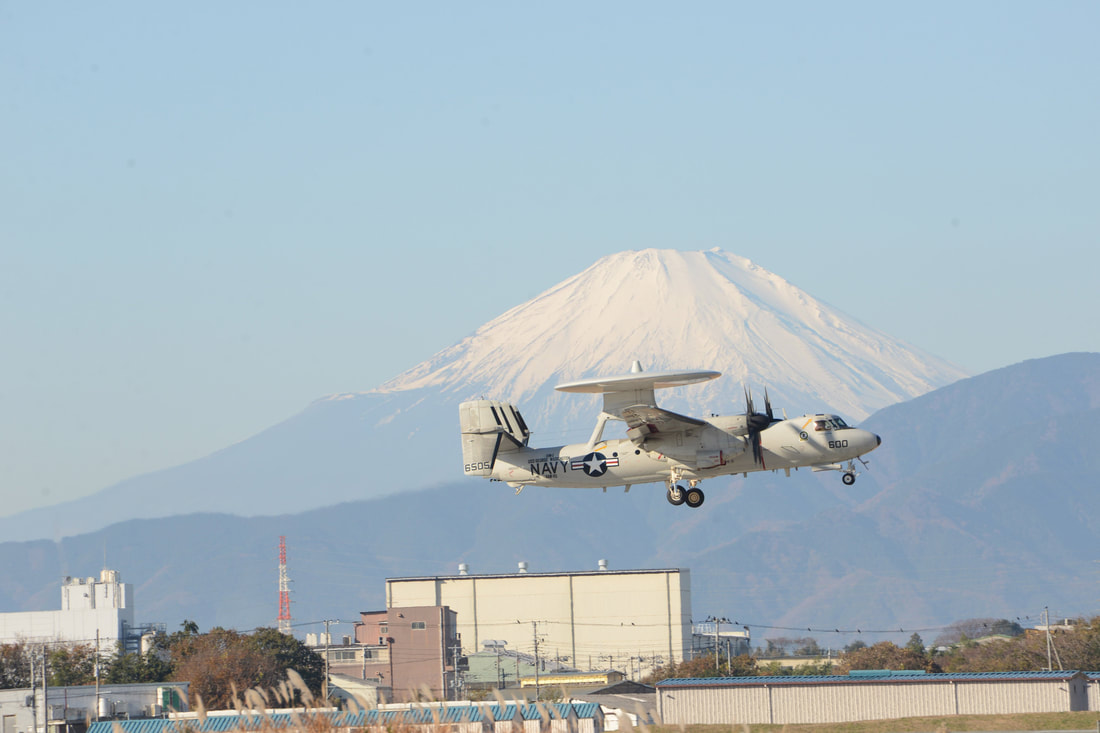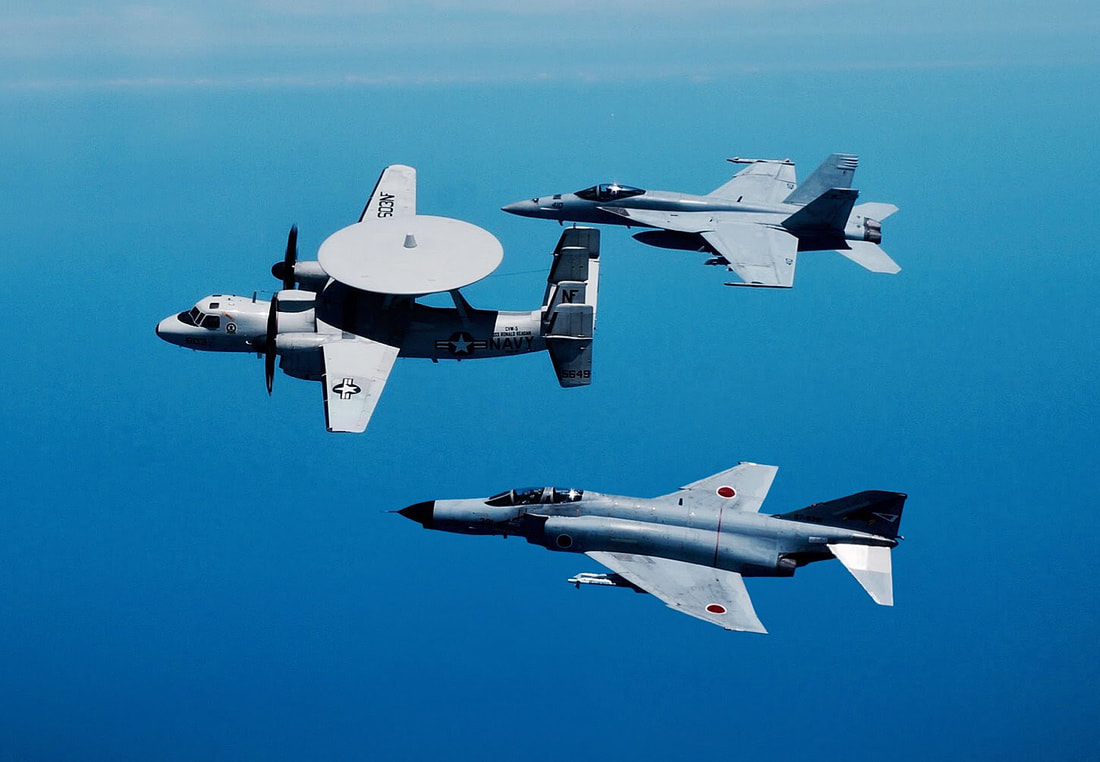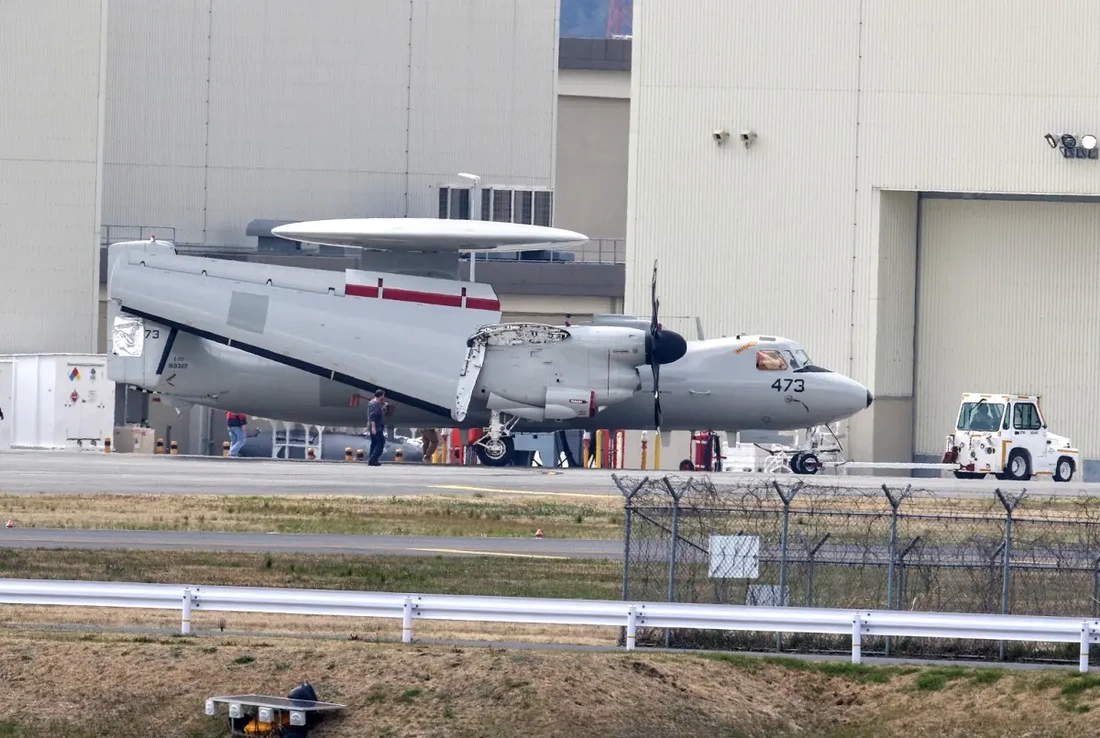E-2C Squadron VAW-115 Leaves Japan After 44 Years of Operations
By: Megan Eckstein
June 6, 2017 10:39 AM
A U.S. Navy E-2C Hawkeye aircraft assigned to Carrier Airborne Early Warning Squadron (VAW) 115 lands on the flight line at Naval Air Facility Atsugi, Japan, Dec. 1, 2013. US Navy photo.
The Navy’s transition from the E-2C Hawkeye to the E-2D Advanced Hawkeye in the Pacific is complete, with the Carrier Airborne Early Warning Squadron (VAW) 115 “Liberty Bells” departing Japan after 44 years of service there.
VAW-115 departed Naval Air Facility Atsugi on June 1 after turning over operational responsibilities to VAW-125, which arrived in Japan in February.
The Navy has said it wants its most advanced capabilities in the Pacific, and despite the Trump Administration calling an end to the “Pacific Pivot” from the Obama Administration, the Navy is still on track to bring more and more capable assets to the region.
VAW-115 arrived in Japan in 1973 and have been at the center of many international events since.
“From the late 1970s throughout the 1980s, VAW-115 made 11 deployments to the Indian Ocean and North Arabian Sea,” according to a Navy news release.
“VAW-115 deployed to the Persian Gulf in October 1990 as part of Operation Desert Shield and transitioned to Desert Storm, flying 179 combat sorties. VAW-115 returned to the Persian Gulf again in 2003 and flew over 350 hours in support of initial major combat operations Operation Iraqi Freedom. In November 2013, VAW-115 flew more than 80 hours in support of Operation Damayan, the multi-national response to the devastation caused by Typhoon Haiyan in the Philippines.
The squadron also flew more than 24 consecutive years, or more than 50,000 flight hours, without a Class A mishap.
VAW-115 will now return to the continental United States, operating out of Naval Base Ventura, Calif., until it upgrades to the E-2D.
The Navy’s transition from the E-2C Hawkeye to the E-2D Advanced Hawkeye in the Pacific is complete, with the Carrier Airborne Early Warning Squadron (VAW) 115 “Liberty Bells” departing Japan after 44 years of service there.
VAW-115 departed Naval Air Facility Atsugi on June 1 after turning over operational responsibilities to VAW-125, which arrived in Japan in February.
The Navy has said it wants its most advanced capabilities in the Pacific, and despite the Trump Administration calling an end to the “Pacific Pivot” from the Obama Administration, the Navy is still on track to bring more and more capable assets to the region.
VAW-115 arrived in Japan in 1973 and have been at the center of many international events since.
“From the late 1970s throughout the 1980s, VAW-115 made 11 deployments to the Indian Ocean and North Arabian Sea,” according to a Navy news release.
“VAW-115 deployed to the Persian Gulf in October 1990 as part of Operation Desert Shield and transitioned to Desert Storm, flying 179 combat sorties. VAW-115 returned to the Persian Gulf again in 2003 and flew over 350 hours in support of initial major combat operations Operation Iraqi Freedom. In November 2013, VAW-115 flew more than 80 hours in support of Operation Damayan, the multi-national response to the devastation caused by Typhoon Haiyan in the Philippines.
The squadron also flew more than 24 consecutive years, or more than 50,000 flight hours, without a Class A mishap.
VAW-115 will now return to the continental United States, operating out of Naval Base Ventura, Calif., until it upgrades to the E-2D.
An E-2C Hawkeye from (VAW) 115, an F/A-18E Super Hornet from (VFA) 195 and an F-4EJ Phantom II fighter from 302nd Tactical Fighter Squadron, Japan Air Self-Defense Force, fly in formation as part of the second annual Benkyoukai training event between the Japan Air Self-Defense Force (JASDF) and Carrier Air Wing Five (CVW 5). US Navy photo.
“VAW-115’s sailors, aircrew, and our families are all extremely grateful for the hospitality that we received from the people of Japan during our time at Atsugi, and for our outstanding partnership with the Japanese Maritime Self Defense Force,” VAW-115’s executive officer Cmdr. Christopher Hulitt said in the news release.
“I want to emphasize that one of our biggest accomplishments is the positive relationships we have developed with the Japanese people and our brothers and sisters in arms of the Japanese Self-Defense Forces. It is tough to say ‘Sayonara,’ but we know that the VAW-125 ‘Tigertails’ will continue to forge these bonds as a part of the U.S.-Japan strategic alliance.”
“VAW-115’s sailors, aircrew, and our families are all extremely grateful for the hospitality that we received from the people of Japan during our time at Atsugi, and for our outstanding partnership with the Japanese Maritime Self Defense Force,” VAW-115’s executive officer Cmdr. Christopher Hulitt said in the news release.
“I want to emphasize that one of our biggest accomplishments is the positive relationships we have developed with the Japanese people and our brothers and sisters in arms of the Japanese Self-Defense Forces. It is tough to say ‘Sayonara,’ but we know that the VAW-125 ‘Tigertails’ will continue to forge these bonds as a part of the U.S.-Japan strategic alliance.”
| kamikazes__the_soviet_legacy.pdf | |
| File Size: | 272 kb |
| File Type: | |
Your browser does not support viewing this document. Click here to download the document.
Japan takes ownership of first E-2D Advanced Hawkeye at Misawa
By HANA KUSUMOTO AND SETH ROBSON | STARS AND STRIPESPublished: June 3, 2019
TOKYO — Japan’s first E-2D Advanced Hawkeye early-warning and control aircraft arrived at Misawa Air Base in late March, according to a spokesman for the Japan Air Self-Defense Force.
The country plans to acquire 13 of the high-tech planes and has allocated $1.8 billion for nine E-2Ds this fiscal year, according to Japan’s 2019 defense budget.
The goal is to “strengthen intelligence, surveillance and reconnaissance capabilities in airspace around Japan including vast air space on the Pacific side,” according to the budget. The new planes will add capability for Japan, which already has E-2C Hawkeyes to surveil its territorial skies and waters, according to the JASDF spokesman.
The U.S. Navy’s Carrier Airborne Early Warning Squadron 125 already flies E-2Ds in Japan out of Marine Corps Air Station Iwakuni.
Japan, which has operated the E-2C since 1983, is the largest E-2 operator outside the United States, the planes’ manufacturer, Northrop Grumman Corp., said in a statement. Japan took delivery of its first E-2D on March 29.
“The E-2D delivers a two-generation leap in radar technology, allowing the aircraft to track threats at extended range,” the company said.
“This aircraft provides a significant increase in early warning and surveillance capability to outpace Japan’s evolving security needs, Jane Bishop, company vice president and integrated product team leader, manned airborne surveillance programs, said in the statement.
The Advanced Hawkeye can be used for humanitarian assistance and disaster relief and for civilian emergency coordination, the company said.
“The E-2D offers interoperability with next-generation aircraft systems and U.S. Navy allies to support regional security cooperation,” the company said.
TOKYO — Japan’s first E-2D Advanced Hawkeye early-warning and control aircraft arrived at Misawa Air Base in late March, according to a spokesman for the Japan Air Self-Defense Force.
The country plans to acquire 13 of the high-tech planes and has allocated $1.8 billion for nine E-2Ds this fiscal year, according to Japan’s 2019 defense budget.
The goal is to “strengthen intelligence, surveillance and reconnaissance capabilities in airspace around Japan including vast air space on the Pacific side,” according to the budget. The new planes will add capability for Japan, which already has E-2C Hawkeyes to surveil its territorial skies and waters, according to the JASDF spokesman.
The U.S. Navy’s Carrier Airborne Early Warning Squadron 125 already flies E-2Ds in Japan out of Marine Corps Air Station Iwakuni.
Japan, which has operated the E-2C since 1983, is the largest E-2 operator outside the United States, the planes’ manufacturer, Northrop Grumman Corp., said in a statement. Japan took delivery of its first E-2D on March 29.
“The E-2D delivers a two-generation leap in radar technology, allowing the aircraft to track threats at extended range,” the company said.
“This aircraft provides a significant increase in early warning and surveillance capability to outpace Japan’s evolving security needs, Jane Bishop, company vice president and integrated product team leader, manned airborne surveillance programs, said in the statement.
The Advanced Hawkeye can be used for humanitarian assistance and disaster relief and for civilian emergency coordination, the company said.
“The E-2D offers interoperability with next-generation aircraft systems and U.S. Navy allies to support regional security cooperation,” the company said.



